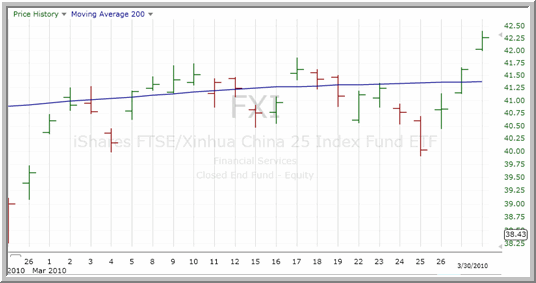High Probability Trading Report: The 200-Day Moving Average and the End of the Month
Buyers appear to be pressing the action again on Wednesday. But as recent trading has shown, we’ll have a much better sense of where the market is headed by the close.
Today’s report touches on a couple of points that high probability traders should keep in mind over the next few days.
Trading Around the 200-Day Moving Average
Generally speaking, it is a good practice to avoid trading stocks or exchange-traded funds when they are near their 200-day moving averages. By “near”, we have found that a range of 0.5% to 1.5% works well.

Above, when the ^FXI^ was trading around its 200-day moving average, it was a good idea for high probability traders to look elsewhere.
Why avoid trading near the 200-day moving average? Our research shows that stock and ETF price movement can become especially unpredictable when markets are trading near the 200-day. Many traders and investors see the 200-day moving average as a major line in the sand between bull markets and bear markets. Because of this, trading behavior as markets pullback to or bounce toward the 200-day moving average can become more emotional and less data-driven. We have found that it is better to wait and choose from among those stocks and ETFs that are not under the potential influence of the 200-day.
The End of the Month Strategy
It remains to be seen whether or not the market continues to follow-through to the upside here at the end of the week. But if buyers do remain on the offensive, it will be little surprise to high probability traders.
Larry Connors and his team at Connors Research uncovered an interesting short-term edge that has to do with trading during the month, when markets have historically tended to rally and when they have tended to move lower. The conclusion of this research, published in Short Term Trading Strategies That Work (click here to order your copy), show a historical pattern of short term outperformance in stocks late in the month.
Importantly, while these edges are significant, with 7 consecutive days late in the month historically closing higher more than 56% of the time, they are not enough alone to trade on. In order to turn this edge into a practical strategy, a high probability trading strategy for short term traders, this edge has been combined with other basic principles of high probability trading such as consecutive lower closes. This step alone has increased the edges each of those 7 days by more than 1%.
With Larry Connors’ High Probability ETF Trading Software, short term traders have access to the same kind of “buy the selling, sell the buying” trading strategies that professional traders have used successfully for decades.
Click here to start your free trial to Larry Connors’ High Probability ETF Trading Software today!
David Penn is Editor in Chief at TradingMarkets.com.
